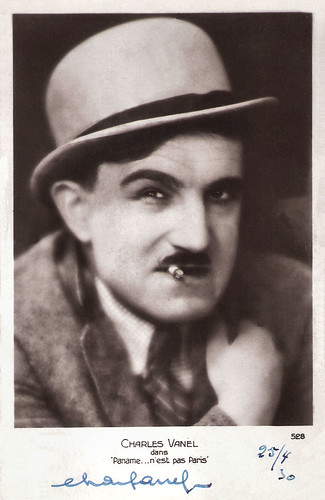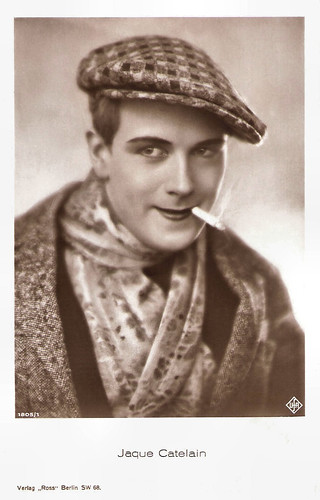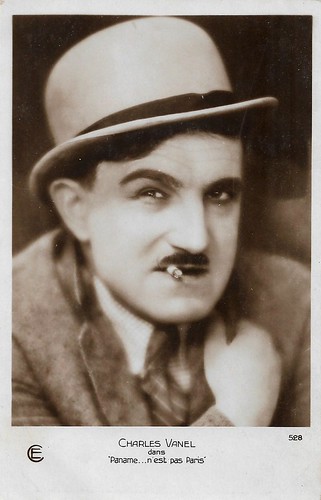Paname...n'est pas Paris/Die Apachen von Paris/Apaches of Paris (Nikolai Malikoff, 1927) was a French silent crime drama, supervised by maestro Marcel L'Herbier. His protege Jaque Catelain plays a young street gangster, who is torn between a good and a bad woman. The French press labelled these criminals in Paris 'Apaches' because of their savage violence. They became a fad, especially after the Apache dance conquered the world.

French postcard by Cinémagazine-Edition, Paris, no. 543. Photo: Jaque Catelain and Ruth Weyer in Paname...n'est pas Paris/Die Apachen von Paris (Nikolai Malikoff, 1927).

French postcard by Cinémagazine-Edition, Paris, no. 528. Photo: Charles Vanel in Paname...n'est pas Paris/Die Apachen von Paris (Nikolai Malikoff, 1927). Signed by Vanel at 25 April 1930.

French postcard by Cinémagazine-Edition, no. 527. Lia Eibenschutz in Paname...n'est pas Paris/ Die Apachen von Paris (Nikolai Malikoff, 1927).
In Paname...n'est pas Paris/ Die Apachen von Paris (Nikolai Malikoff, 1927), Jaque Catelain plays the young Milord who is part of a gang of criminals as well as his companion, Mama Savonette (Ruth Weyher).
Milord is under the spell of Winnie Rowlandson (Lia Eibenschütz) and hesitates to steal her bracelet. He plans to make amends, but becoming an honest boy is more difficult than Milord supposes...
The cast was a mix of French and German actors. Mylord's opponent, the Apache Bécot, was played by the great Charles Vanel. Other actors were the Frenchman Bondy, and from Germany Olga Limburg and Jakob Tiedtke.
The Director of the film was the Russian director Nikolai Malikoff, assisted by Georges Lampin. The famous French director Marcel L'Herbier was the producer supervisor. The film's art direction was done by the later film director Claude Autant-Lara and Vladimir Meingard.
The Franco-German co-production, by L'Alliance Cinématographique Européenne (ACE) and the Ufa, had a difficult production history. According to Cinémagazine, a fire broke out on Thursday 31 July 1927 in the editing room of the G. M. Film factory in Billancourt, where the film was being developed.
At the time of the fire, the film had just been finished. The producers decided to re-shoot the film completely. The German premiere took place on 17 December 1927 in Berlin at the Gloria-Palast cinema. The French premiere was on 17 February 1928.

French postcard by Cinémagazine-Edition, no. 525. Signed by Jaque Catelain in 1929.

French postcard by Cinémagazine-Edition, no. 526. Ruth Weyher in Paname...n'est pas Paris/Die Apachen von Paris (Nikolai Malikoff, 1927).

German postcard by Ross Verlag, no. 1805/1, 1927-1928. Photo: Ufa.
'Paname' is the 'argot' (slang) name for Paris and its suburbs. But there is a difference between the two. Paname is the hidden Paris, the dark and dangerous Paris of the criminals and the prostitutes. During the First World War, the term took off and was used in songs.
'Apache' literally refers to the Native American Apache tribe, but had the additional meaning in French of a Paris street gangster. After a particularly heinous crime in 1902, the newspaper reporter Authur Dupin wrote the headline "Crime Committed by the Apaches of Belleville," referring to the perceived savagery of the American Indians described in James Fenimore Cooper novels, popular at that time. The French pronounce it "a-PAHSH", and the term stuck.
In 1900, the name was also taken up by a group of young artists including the composers Claude Debussy, Manuel de Falla, and Maurice Ravel. Inadvertently they bumped once into a newspaper seller who exclaimed "Attention les apaches". They soon adopted the name, which Ravel suggested that they adopt the first melody of Borodin's 2nd Symphony as their theme, an idea with which they all agreed. The group met each Saturday and rallied around Claude Debussy's opera 'Pelléas et Mélisande' at and after its controversial premiere.
The young Apaches of Montmartre, Belleville, and the Barrières swaggered with arrogant pride, dressed distinctively and were handy with a knife. In 1908, American dancer Maurice Mouvet and French actor and dancer Max Dearly began to visit the low bars frequented by Apaches in a search for inspiration for new dances. They formulated the new dance from moves seen there and gave to it the name Apache, according to Wikipedia and other sources. Max Dearly first performed it in 1908 in Paris at the Ambassadeurs and Maurice in Ostend at the Kursaal. A short while later, in the summer of 1908, Maurice and his partner Leona performed the dance at Maxim's, and Max Dearly made an even bigger impact with it, partnered with Mistinguett, in the Moulin Rouge show, 'La Revue du Moulin'.
However, Mistinguett later claimed that she had invented the Apache dance. Who was right? Dance historian Richard Powers wrote an interesting article about the history of the Apache dance. Powers: "with a Mr. Paulo as her partner, Mistinguett took the low-class hugging a step further and invented 'The Cake Walk of the Barrières', which was a mock fight-as-dance between a hooligan from the low-class Barrières, and his woman. This new dance was described, with photos, in the same 1903 issue of Paris qui Chante. The illustrations show the street thug violently threatening the woman, and pulling her by her hair. The article described the dance as "vulgar and amazing at the same time." Like her 'Cake-Walk Parisien', this mock battle was entertainment, a fiction. Mistinguett never stated that there was any prototype of men choreographically abusing women in reality. This dance also went by another name, 'La Valse Chaloupee', or 'Swaying Waltz', and later as 'La danse du Pavé', 'Danse Apache' and 'Valse Apache'."
So Mistinguett created the Apache dance, five years before she partnered Max Dearly at the Moulin Rouge. The Apache dance reenacts a violent 'discussion' between an Apache, a pimp and a gigolette, a young prostitute. It includes mock slaps and punches, the man picking up and throwing the woman to the ground, or lifting and carrying her while she struggles or feigns unconsciousness. Thus, the dance shares many features with the theatrical discipline of stage combat. In some versions of the dance, the woman may fight back. The Apache remained a popular cabaret act through the 1960s.
The Apaches also figured in early French films, such as in Georges Mélies' short comedy Les Apaches (1904). The famous French film serial Les Vampires (Louis Feuillade, 1915) about the Apache gang called 'Les Vampires' contains a number of Apache dance scenes. A notable detail is that during a part of the waltz the man holds firmly onto the woman's hair, rather than her body. Apache dances also figured in many international films. And in Paname...n'est pas Paris/Die Apachen von Paris (Nikolai Malikoff, 1927).

Mistinguett and Max Dearly. French postcard by F.C. & Cie, no. 283. Photo: Boyer & Bert. Collection: Didier Hanson.

French postcard by Cinémagazine-Edition, Paris, no. 528. Photo: Charles Vanel in Paname...n'est pas Paris/Die Apachen von Paris (Nikolai Malikoff, 1927).
Excerpt from Paname...n'est pas Paris/Die Apachen von Paris (Nikolai Malikoff, 1927). Source: Maximilian Guth (YouTube).
Sources: Richard Powers (The hidden story of the Apache dance), Wikipedia (English and English) and IMDb.

French postcard by Cinémagazine-Edition, Paris, no. 543. Photo: Jaque Catelain and Ruth Weyer in Paname...n'est pas Paris/Die Apachen von Paris (Nikolai Malikoff, 1927).

French postcard by Cinémagazine-Edition, Paris, no. 528. Photo: Charles Vanel in Paname...n'est pas Paris/Die Apachen von Paris (Nikolai Malikoff, 1927). Signed by Vanel at 25 April 1930.

French postcard by Cinémagazine-Edition, no. 527. Lia Eibenschutz in Paname...n'est pas Paris/ Die Apachen von Paris (Nikolai Malikoff, 1927).
A fire in the editing room
In Paname...n'est pas Paris/ Die Apachen von Paris (Nikolai Malikoff, 1927), Jaque Catelain plays the young Milord who is part of a gang of criminals as well as his companion, Mama Savonette (Ruth Weyher).
Milord is under the spell of Winnie Rowlandson (Lia Eibenschütz) and hesitates to steal her bracelet. He plans to make amends, but becoming an honest boy is more difficult than Milord supposes...
The cast was a mix of French and German actors. Mylord's opponent, the Apache Bécot, was played by the great Charles Vanel. Other actors were the Frenchman Bondy, and from Germany Olga Limburg and Jakob Tiedtke.
The Director of the film was the Russian director Nikolai Malikoff, assisted by Georges Lampin. The famous French director Marcel L'Herbier was the producer supervisor. The film's art direction was done by the later film director Claude Autant-Lara and Vladimir Meingard.
The Franco-German co-production, by L'Alliance Cinématographique Européenne (ACE) and the Ufa, had a difficult production history. According to Cinémagazine, a fire broke out on Thursday 31 July 1927 in the editing room of the G. M. Film factory in Billancourt, where the film was being developed.
At the time of the fire, the film had just been finished. The producers decided to re-shoot the film completely. The German premiere took place on 17 December 1927 in Berlin at the Gloria-Palast cinema. The French premiere was on 17 February 1928.

French postcard by Cinémagazine-Edition, no. 525. Signed by Jaque Catelain in 1929.

French postcard by Cinémagazine-Edition, no. 526. Ruth Weyher in Paname...n'est pas Paris/Die Apachen von Paris (Nikolai Malikoff, 1927).

German postcard by Ross Verlag, no. 1805/1, 1927-1928. Photo: Ufa.
Paname and the Apaches
'Paname' is the 'argot' (slang) name for Paris and its suburbs. But there is a difference between the two. Paname is the hidden Paris, the dark and dangerous Paris of the criminals and the prostitutes. During the First World War, the term took off and was used in songs.
'Apache' literally refers to the Native American Apache tribe, but had the additional meaning in French of a Paris street gangster. After a particularly heinous crime in 1902, the newspaper reporter Authur Dupin wrote the headline "Crime Committed by the Apaches of Belleville," referring to the perceived savagery of the American Indians described in James Fenimore Cooper novels, popular at that time. The French pronounce it "a-PAHSH", and the term stuck.
In 1900, the name was also taken up by a group of young artists including the composers Claude Debussy, Manuel de Falla, and Maurice Ravel. Inadvertently they bumped once into a newspaper seller who exclaimed "Attention les apaches". They soon adopted the name, which Ravel suggested that they adopt the first melody of Borodin's 2nd Symphony as their theme, an idea with which they all agreed. The group met each Saturday and rallied around Claude Debussy's opera 'Pelléas et Mélisande' at and after its controversial premiere.
The young Apaches of Montmartre, Belleville, and the Barrières swaggered with arrogant pride, dressed distinctively and were handy with a knife. In 1908, American dancer Maurice Mouvet and French actor and dancer Max Dearly began to visit the low bars frequented by Apaches in a search for inspiration for new dances. They formulated the new dance from moves seen there and gave to it the name Apache, according to Wikipedia and other sources. Max Dearly first performed it in 1908 in Paris at the Ambassadeurs and Maurice in Ostend at the Kursaal. A short while later, in the summer of 1908, Maurice and his partner Leona performed the dance at Maxim's, and Max Dearly made an even bigger impact with it, partnered with Mistinguett, in the Moulin Rouge show, 'La Revue du Moulin'.
However, Mistinguett later claimed that she had invented the Apache dance. Who was right? Dance historian Richard Powers wrote an interesting article about the history of the Apache dance. Powers: "with a Mr. Paulo as her partner, Mistinguett took the low-class hugging a step further and invented 'The Cake Walk of the Barrières', which was a mock fight-as-dance between a hooligan from the low-class Barrières, and his woman. This new dance was described, with photos, in the same 1903 issue of Paris qui Chante. The illustrations show the street thug violently threatening the woman, and pulling her by her hair. The article described the dance as "vulgar and amazing at the same time." Like her 'Cake-Walk Parisien', this mock battle was entertainment, a fiction. Mistinguett never stated that there was any prototype of men choreographically abusing women in reality. This dance also went by another name, 'La Valse Chaloupee', or 'Swaying Waltz', and later as 'La danse du Pavé', 'Danse Apache' and 'Valse Apache'."
So Mistinguett created the Apache dance, five years before she partnered Max Dearly at the Moulin Rouge. The Apache dance reenacts a violent 'discussion' between an Apache, a pimp and a gigolette, a young prostitute. It includes mock slaps and punches, the man picking up and throwing the woman to the ground, or lifting and carrying her while she struggles or feigns unconsciousness. Thus, the dance shares many features with the theatrical discipline of stage combat. In some versions of the dance, the woman may fight back. The Apache remained a popular cabaret act through the 1960s.
The Apaches also figured in early French films, such as in Georges Mélies' short comedy Les Apaches (1904). The famous French film serial Les Vampires (Louis Feuillade, 1915) about the Apache gang called 'Les Vampires' contains a number of Apache dance scenes. A notable detail is that during a part of the waltz the man holds firmly onto the woman's hair, rather than her body. Apache dances also figured in many international films. And in Paname...n'est pas Paris/Die Apachen von Paris (Nikolai Malikoff, 1927).

Mistinguett and Max Dearly. French postcard by F.C. & Cie, no. 283. Photo: Boyer & Bert. Collection: Didier Hanson.

French postcard by Cinémagazine-Edition, Paris, no. 528. Photo: Charles Vanel in Paname...n'est pas Paris/Die Apachen von Paris (Nikolai Malikoff, 1927).
Excerpt from Paname...n'est pas Paris/Die Apachen von Paris (Nikolai Malikoff, 1927). Source: Maximilian Guth (YouTube).
Sources: Richard Powers (The hidden story of the Apache dance), Wikipedia (English and English) and IMDb.
No comments:
Post a Comment